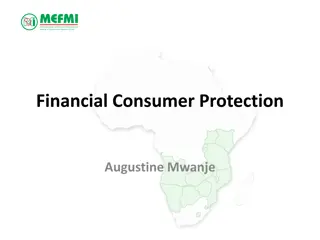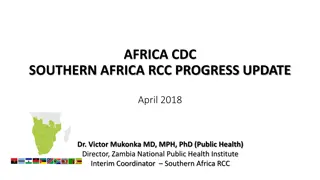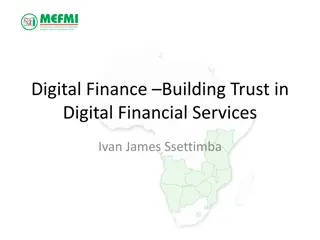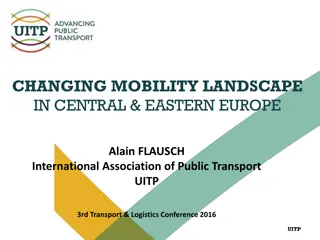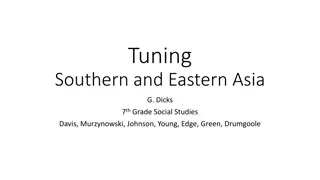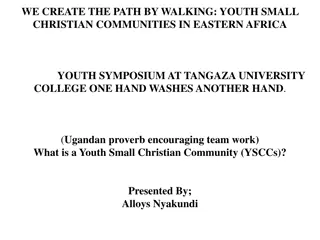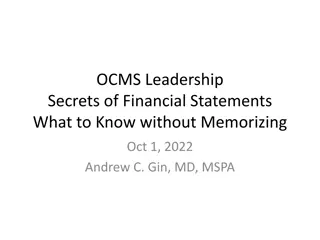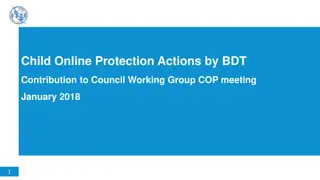Financial Literacy Initiatives for Marginalized Groups in Eastern and Southern Africa
This presentation by the Macroeconomic and Financial Management Institute delves into the importance of financial literacy for marginalized groups such as women, youth, rural populations, the elderly, and the disabled in Eastern and Southern Africa. It emphasizes the need to identify and support these groups through tailored financial education to empower them for better financial management and decision-making.
Download Presentation

Please find below an Image/Link to download the presentation.
The content on the website is provided AS IS for your information and personal use only. It may not be sold, licensed, or shared on other websites without obtaining consent from the author.If you encounter any issues during the download, it is possible that the publisher has removed the file from their server.
You are allowed to download the files provided on this website for personal or commercial use, subject to the condition that they are used lawfully. All files are the property of their respective owners.
The content on the website is provided AS IS for your information and personal use only. It may not be sold, licensed, or shared on other websites without obtaining consent from the author.
E N D
Presentation Transcript
Macroeconomic and Financial Management Institute of Eastern and Southern Africa Financial Literacy For Marginalized Groups Augustine Mwanje
Macroeconomic and Financial Management Institute of Eastern and Southern Africa Agenda Introduction Identification of marginalized groups Approaches used for these marginalized groups Conclusion 2
Macroeconomic and Financial Management Institute of Eastern and Southern Africa Introduction It is important to identify which groups in society are : The least financially literate, therefore in need of financial education Most vulnerable and therefore more likely to suffer significantly unless they become more financially literate likely to be most receptive thereby taking advantage of, and learning from, financial literacy initiatives 3
Macroeconomic and Financial Management Institute of Eastern and Southern Africa Identification of Marginalized Groups In many developing nations, certain segments of society tend to be marginalized either due to cultural, religious and other socio-economic factors. These segments include: Women Youth Rural population The elderly The disabled 4
Macroeconomic and Financial Management Institute of Eastern and Southern Africa Identification of Marginalized Groups Women Typically have fewer financial resources than men and live longer on average than men. They also have lower confidence than men in their financial knowledge and skills and tend to be more risk averse. In many cases, lack control over cash management within their household and may be dependent on their husband to access financial services. 5
Macroeconomic and Financial Management Institute of Eastern and Southern Africa Identification of Marginalized Groups Youth Many are taking responsibility for managing their finances for the first time, and in most cases have received little or no financial education while at school. Younger people tend to learn better, and have many decades ahead of them in which to benefit from becoming more financially literate. 6
Macroeconomic and Financial Management Institute of Eastern and Southern Africa Identification of Marginalized Groups Rural Population In most emerging economies, only a small percentage of the population has access to formal financial services The attention of many central banks around the world has been drawn to formulating policies to address the broader concept extending financial services to the underserved or unbanked population 7
Macroeconomic and Financial Management Institute of Eastern and Southern Africa Identification of Marginalized Groups The Disabled May rely on the help of others to act on their behalf due to physical or cognitive impairments Rarely get access to a formal education that would help in making sound financial decisions Struggle to be gainfully employed 8
Macroeconomic and Financial Management Institute of Eastern and Southern Africa Approaches Women Use of female trainers as role models to build confidence among trainees is important. Women tend to be aware of their lack of financial knowledge, making them potentially more teachable . Acknowledgment that lack of time due to work/social obligations can be a constraint. 9
Macroeconomic and Financial Management Institute of Eastern and Southern Africa Approaches Youth The youth have few role models and mentors for the youth to provide guidance on money management and financial issues. It is easier to instill the right values, attitudes and perceptions among young people than to change the habits and perceptions of older people. This can be done through youth clubs, associations and support organizations 10
Macroeconomic and Financial Management Institute of Eastern and Southern Africa Approaches Youth Financial education and information can be provided via magazines, radio, television programmes, SMS messages, social networking sites, websites and other forms of on-line media which appeal to them. The language used should also be easy for them to relate to, and the message should be relevant to their situation. The content should be engaging, and entertaining. 11
Macroeconomic and Financial Management Institute of Eastern and Southern Africa Approaches Rural Population More likely to be receptive to financial education and training if it is delivered by people: Who they know, like and trust Who can talk about their personal experiences, in ways with which the target audience can relate These include: religious leaders, church based organizations, local leaders and community-based organizations. Many also trust and believe what they hear on radio 12
Macroeconomic and Financial Management Institute of Eastern and Southern Africa Approaches Rural Population Personal finance education and training can be provided via SACCO, VSLA and MFI group meetings. This is because these organizations gather their members or clients to discuss financial issues that help them manage their finances well so they can make the most out of the financial services they provide. Training materials need to be adapted and translated to the local language for illiterate and semi-literate people. 13
Macroeconomic and Financial Management Institute of Eastern and Southern Africa Approaches The Disabled Mindset Issues Disability does not mean Inability They rarely earn an income and are usually dependants which leads to exclusion Without a reliable relationship with financial institutions, they may rely on second-hand advice from people in their personal network, which can be misleading or inaccurate A training needs analysis is essential as it helps eliminate assumptions 14
Macroeconomic and Financial Management Institute of Eastern and Southern Africa Approaches The Disabled Incorporation of images of people with disabilities in the educational materials Training venues must be accessible to people with disabilities Information sharing should include group discussion activities and use of multimedia Patience, flexible timelines and a flexible program schedule are also critical 15
Macroeconomic and Financial Management Institute of Eastern and Southern Africa Conclusion There is no one-size-fits-all approach to a financial literacy strategy, given the various characteristics of the different segments of a nation s population. Tailoring the specific approach based on the target audience is therefore a critical success factor 16
Macroeconomic and Financial Management Institute of Eastern and Southern Africa Thank You Any Questions? 17
Macroeconomic and Financial Management Institute of Eastern and Southern Africa References and Bibliography Towards an Effective Framework for Financial Literacy and Financial Consumer Protection in Uganda (GIZ & Bank of Uganda, March 2011) Strategy for Financial Literacy in Uganda (Bank of Uganda, August 2013) National Financial Literacy Framework (Central Bank of Nigeria, October 2015) 18





